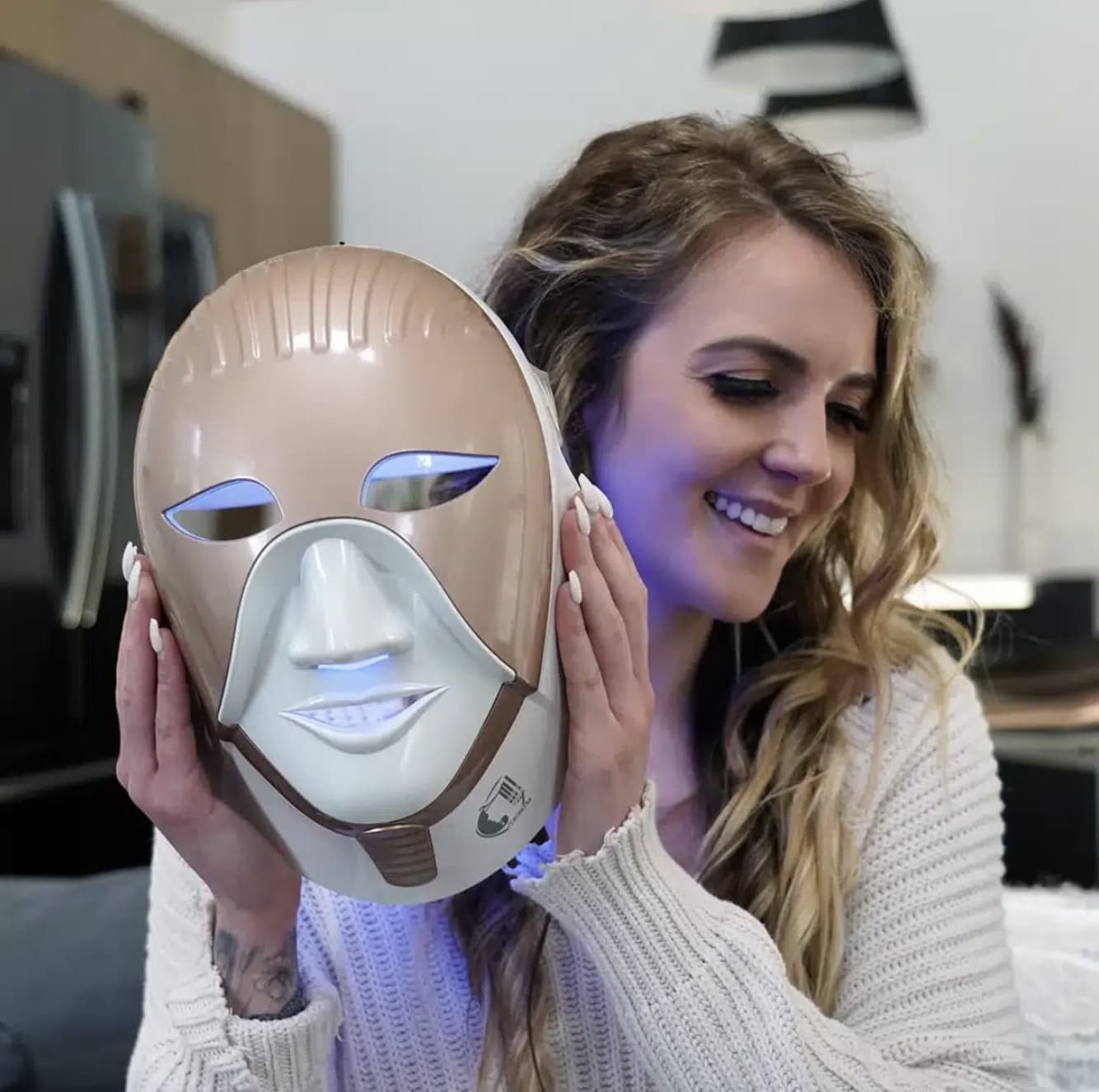As a beauty expert who’s tested countless at-home devices, the Cleopatra LED Mask immediately stood out for two reasons: its full face-and-neck coverage and its seven-wavelength versatility. After integrating it into my routine for several weeks, I can confidently say this is one of the most comprehensive, spa-grade LED masks designed for home use—especially for those managing multiple concerns like dullness, breakouts, redness, and early fine lines all at once.
Table of Contents
Design & Build: Full-Coverage, High-Density LEDs
The Cleopatra LED Mask uses 192 high-density LEDs distributed across the face and neck, which is a critical differentiator from many competitors that either skip neck coverage or use fewer diodes (leading to uneven irradiance). In real use, this density translates into more uniform light exposure; I noticed fewer missed zones around the jawline and lateral neck—areas that often betray age early. The device is wireless and rechargeable via USB‑C, with intuitive tap-to-control functionality on the forehead, which makes color and intensity switching straightforward during a session. It also includes protective silicone eye inserts, a thoughtful touch for those with light sensitivity or dry eyes.
Fit-wise, the mask is solid and structured rather than floppy, which helps the LEDs maintain consistent proximity to skin; however, it isn’t feather-light, so sessions are best done reclined for comfort. That said, the wireless design and storage case make daily use genuinely convenient in a home setting.

The Seven Light Modes: Customizing to Skin’s Daily Needs
What I appreciate most about Cleopatra is the seven-color system, which lets me tailor treatments to what my skin is doing that day—whether it’s hormonal congestion, lack of glow, or fatigue lines. Here’s how I used each mode and what it’s designed to do:
- Red (650–950nm): My go-to anti-aging selection for boosting collagen/elastin and softening fine lines; I also noticed improvement in overall resilience and bounce.
- Blue (450–495nm): Ideal during breakout-prone weeks; used as a targeted anti-acne antibacterial and anti-inflammatory step, especially around chin and jawline.
- Green (495–570nm): Helps modulate oil and even tone; I like it before makeup days when I want a smoother, balanced canvas.
- Yellow (570–650nm): Gentle brightening and calming; it pairs nicely after acid nights or retinoid off-days to reduce the look of surface redness.
- Purple: A red+blue combination intended to support healing while keeping congestion in check; I used this after extractions or when barrier felt slightly taxed.
- Cyan: Soothing, great on days of wind exposure or post-sun sensitivity; it’s a nice “spa recovery” mode for reactive moments.
- White: Marketed for deeper tissue rejuvenation and repair; I used this as a weekly reset following more intensive skincare cycles.
From a broader safety and efficacy lens, red and near‑infrared light are well-established for skin regeneration, while blue remains a staple for acne—though with blue light, protective eyewear is prudent and instructions should be followed carefully if eyes are sensitive. Consistency remains the non-negotiable for LED outcomes; even expert panels note that appropriate wavelengths, diode quality, and regular use determine results over time.
Routine Integration & Results
I ran 15–20 minute sessions, 5–6 days a week, typically after cleansing and before serums to reduce any barrier between the LEDs and skin. On weeks with more congestion, I rotated blue or purple; on maintenance weeks, I emphasized red, green, and yellow for firming, balancing, and brightening. Within a couple of weeks, I observed better clarity around the chin, a more even tone, and a softening of fine dehydration lines around the nasolabial area—subtle but noticeable in side-lighting. The neck benefits stood out: cumulative smoothing and a more refined texture under the chin due to the extended coverage that many masks simply don’t provide.
The mask runs cool and doesn’t produce heat, which supports tolerability for sensitive skin and reduces the risk of post-inflammatory flare-ups when used correctly. While at-home devices cannot fully replicate in-office LED irradiance, device quality and diode density matter—and Cleopatra’s high-density layout helps close that gap for home maintenance.
Ease of Use, Comfort, and Practical Notes
- Wireless, USB‑C charging, and tap controls make setup and switching modes seamless; I found it fast to integrate even on busy evenings.
- Silicone eye inserts make sessions more comfortable, particularly on blue and white modes, and are a helpful safety-forward inclusion.
- Due to weight, lying down is more comfortable; this is not a mask to wear while walking around—think “passive ritual,” not “multitasker”.
- The storage case is a plus for keeping lenses and interior surfaces dust-free, which helps maintain light clarity and hygiene.
How It Stacks Up
In a market crowded with strong options, Cleopatra distinguishes itself with its combination of seven wavelengths, high diode count, and neck coverage, often at a lower price than premium silicone masks focused on 1–3 wavelengths. While some flexible silicone models win on comfort and travel, they typically forgo neck treatment or use fewer LEDs, which affects evenness and coverage. For those prioritizing results over portability, Cleopatra’s engineering choices make sense.
Safety & Who It’s For
LED masks are generally considered safe when used as directed, but anyone with photosensitive conditions, light‑sensitive migraines, or on photosensitizing medications should consult a clinician before use; blue light in particular warrants caution around eyes, and protective eyewear is wise for sensitive individuals. For most skin types seeking cumulative improvements in clarity, tone, and firmness, consistent LED use can be a valuable adjunct to topical routines—especially for those who want benefits across face and neck.
The Verdict: Is the Cleopatra LED Mask Worth Buying?
Yes. For users who want multi-wavelength flexibility, robust face-and-neck coverage, and high-density LEDs in a wireless, at-home format, the Cleopatra LED Mask delivers compelling value and performance. The seven-color system lets treatments evolve with skin’s changing needs, the 192-LED build ensures even illumination, and the wireless, tap-to-control design makes regular use realistic—key for seeing results. Given its comprehensive feature set and the tangible improvements achievable with consistent use, it’s worth buying.